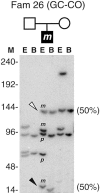Mechanism and timing of mitotic rearrangements in the subtelomeric D4Z4 repeat involved in facioscapulohumeral muscular dystrophy
- PMID: 15154112
- PMCID: PMC1182007
- DOI: 10.1086/422175
Mechanism and timing of mitotic rearrangements in the subtelomeric D4Z4 repeat involved in facioscapulohumeral muscular dystrophy
Abstract
Autosomal dominant facioscapulohumeral muscular dystrophy (FSHD1A) is associated with contractions of the polymorphic D4Z4 repeat on chromosome 4qter. Almost half of new FSHD mutations occur postfertilization, resulting in somatic mosaicism for D4Z4. Detailed D4Z4 analysis of 11 mosaic individuals with FSHD revealed a mosaic mixture of a contracted FSHD-sized allele and the unchanged ancestral allele in 8 cases, which is suggestive of a mitotic gene conversion without crossover. However, in 3 cases, the D4Z4 rearrangement resulted in two different-sized D4Z4 repeats, indicative of a gene conversion with crossover. In all cases, DNA markers proximal and distal to D4Z4 showed no allelic exchanges, suggesting that all rearrangements were intrachromosomal. We propose that D4Z4 rearrangements occur via a synthesis-dependent strand annealing model that relatively frequently allows for crossovers. Furthermore, the distribution of different cell populations in mosaic patients with FSHD suggests that mosaicism here results from D4Z4 rearrangements occurring during the first few zygotic cell divisions after fertilization.
Figures



Similar articles
-
The D4Z4 repeat-mediated pathogenesis of facioscapulohumeral muscular dystrophy.Am J Hum Genet. 2005 Mar;76(3):375-86. doi: 10.1086/428361. Epub 2005 Jan 24. Am J Hum Genet. 2005. PMID: 15674778 Free PMC article. Review. No abstract available.
-
Specific sequence variations within the 4q35 region are associated with facioscapulohumeral muscular dystrophy.Am J Hum Genet. 2007 Nov;81(5):884-94. doi: 10.1086/521986. Epub 2007 Sep 7. Am J Hum Genet. 2007. PMID: 17924332 Free PMC article.
-
De novo facioscapulohumeral muscular dystrophy: frequent somatic mosaicism, sex-dependent phenotype, and the role of mitotic transchromosomal repeat interaction between chromosomes 4 and 10.Am J Hum Genet. 2000 Jan;66(1):26-35. doi: 10.1086/302730. Am J Hum Genet. 2000. PMID: 10631134 Free PMC article.
-
Recurrent somatic mosaicism for D4Z4 contractions in a family with facioscapulohumeral muscular dystrophy.Neuromuscul Disord. 2005 Jul;15(7):471-5. doi: 10.1016/j.nmd.2005.03.005. Neuromuscul Disord. 2005. PMID: 15935668
-
Genomic analysis of facioscapulohumeral muscular dystrophy.Brief Funct Genomic Proteomic. 2003 Oct;2(3):213-23. doi: 10.1093/bfgp/2.3.213. Brief Funct Genomic Proteomic. 2003. PMID: 15239924 Review.
Cited by
-
New multiplex PCR-based protocol allowing indirect diagnosis of FSHD on single cells: can PGD be offered despite high risk of recombination?Eur J Hum Genet. 2010 May;18(5):533-8. doi: 10.1038/ejhg.2009.207. Epub 2009 Nov 25. Eur J Hum Genet. 2010. PMID: 19935833 Free PMC article.
-
Facioscapulohumeral muscular dystrophy-Reproductive counseling, pregnancy, and delivery in a complex multigenetic disease.Clin Genet. 2022 Feb;101(2):149-160. doi: 10.1111/cge.14031. Epub 2021 Aug 1. Clin Genet. 2022. PMID: 34297364 Free PMC article. Review.
-
Autosomal dominant in cis D4Z4 repeat array duplication alleles in facioscapulohumeral dystrophy.Brain. 2024 Feb 1;147(2):414-426. doi: 10.1093/brain/awad312. Brain. 2024. PMID: 37703328 Free PMC article.
-
Chromosome 10q-linked FSHD identifies DUX4 as principal disease gene.J Med Genet. 2022 Feb;59(2):180-188. doi: 10.1136/jmedgenet-2020-107041. Epub 2021 Jan 12. J Med Genet. 2022. PMID: 33436523 Free PMC article.
-
The D4Z4 repeat-mediated pathogenesis of facioscapulohumeral muscular dystrophy.Am J Hum Genet. 2005 Mar;76(3):375-86. doi: 10.1086/428361. Epub 2005 Jan 24. Am J Hum Genet. 2005. PMID: 15674778 Free PMC article. Review. No abstract available.
References
Electronic-Database Information
-
- GenBank, http://www.ncbi.nlm.nih.gov/Genbank/ (for the D4Z4 allele [accession number AF117653], distal 4qB sequence [accession number AF017466], and distal 4qA sequence [accession numbers U74496 and U74497])
-
- Online Mendelian Inheritance in Man (OMIM), http://www.ncbi.nlm.nih.gov/Omim/ (for FSHD1A) - PubMed
References
-
- Brouwer OF, Padberg GW, Ruys CJ, Brand R, de Laat JA, Grote JJ (1991) Hearing loss in facioscapulohumeral muscular dystrophy. Neurology 41:1878–1881 - PubMed
-
- Funakoshi M, Goto K, Arahata K (1998) Epilepsy and mental retardation in a subset of early onset 4q35-facioscapulohumeral muscular dystrophy. Neurology 50:1791–1794 - PubMed
-
- Gabriels J, Beckers MC, Ding H, De Vriese A, Plaisance S, van der Maarel SM, Padberg GW, Frants RR, Hewitt JE, Collen D, Belayew A (1999) Nucleotide sequence of the partially deleted D4Z4 locus in a patient with FSHD identifies a putative gene within each 3.3 kb element. Gene 236:25–3210.1016/S0378-1119(99)00267-X - DOI - PubMed
-
- Galluzzi G, Deidda G, Cacurri S, Colantoni L, Piazzo N, Vigneti E, Ricci E, Servidei S, Merico B, Pachi A, Brambati B, Mangiola F, Tonali P, Felicetti L (1999) Molecular analysis of 4q35 rearrangements in fascioscapulohumeral muscular dystrophy (FSHD): application to family studies for a correct genetic advice and a reliable prenatal diagnosis of the disease. Neuromuscul Disord 9:190–19810.1016/S0960-8966(98)00116-3 - DOI - PubMed
Publication types
MeSH terms
LinkOut - more resources
Full Text Sources
Research Materials

